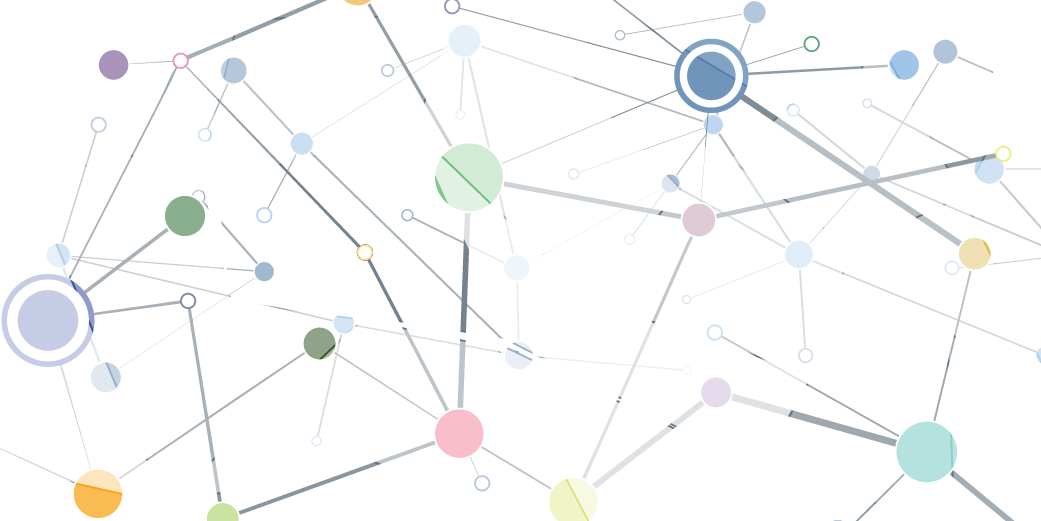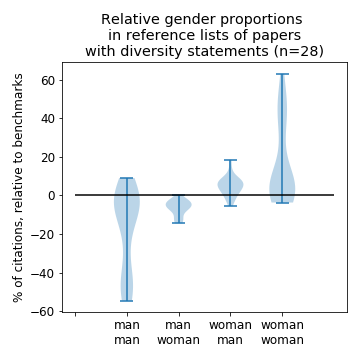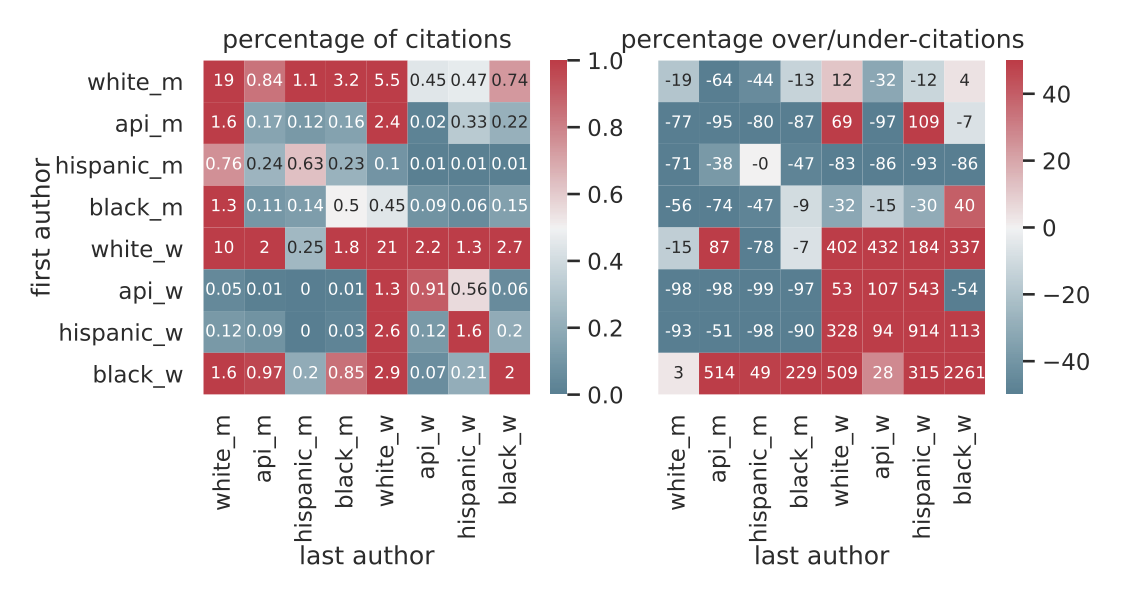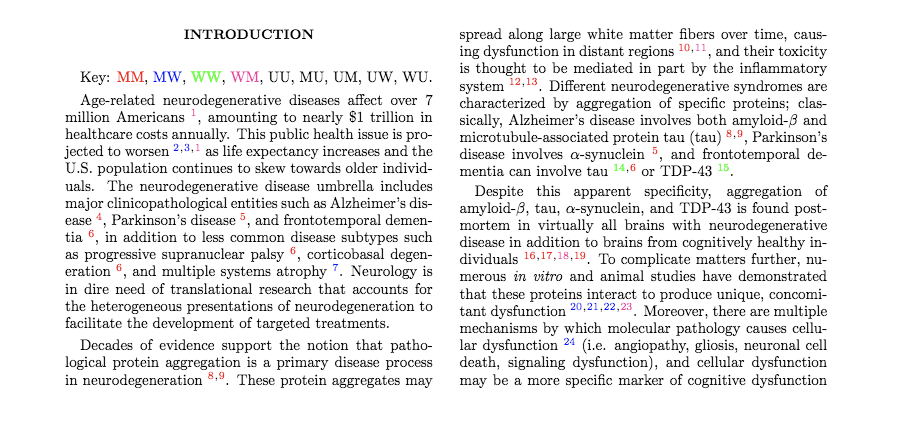Motivated from work by:
-
J. D. Dworkin, K. A. Linn, E. G. Teich, P. Zurn, R. T. Shinohara, and D. S. Bassett (2020). The extent and drivers of gender imbalance in neuroscience reference lists. Nature Neuroscience. doi: https://doi.org/10.1038/s41593-020-0658-y
-
M.A. Bertolero, J.D. Dworkin, S.U. David, C. López Lloreda, P. Srivastava, J. Stiso, D. Zhou, K. Dzirasa, D.A. Fair, A.N. Kaczkurkin, B.J. Marlin, D. Shohamy, L.Q. Uddin, P. Zurn, D.S. Bassett (2020). Racial and ethnic imbalance in neuroscience reference lists and intersections with gender. bioRxiv. doi: https://doi.org/10.1101/2020.10.12.336230
See also these Perspectives with actionable recommendations moving forward for scientists at all levels:
- J. D. Dworkin, P. Zurn, and D. S. Bassett (2020). (In)citing Action to Realize an Equitable Future. Neuron. doi: https://doi.org/10.1016/j.neuron.2020.05.011
- P. Zurn, D.S. Bassett, and N.C. Rust (2020). "The Citation Diversity Statement: A Practice of Transparency, A Way of Life." Trends in Cognitive Sciences doi: https://doi.org/10.1016/j.tics.2020.06.009
And editorials and research highlights of this work:
- A.L. Fairhall and E. Marder (2020). Acknowledging female voices. Nature Neuroscience. doi: https://doi.org/10.1038/s41593-020-0667-x
- Widening the scope of diversity (2020). Nature Neuroscience. doi: https://doi.org/10.1038/s41593-020-0670-2
- Z. Budrikis (2020). Growing citation gender gap. Nature Reviews Physics. doi: https://doi.org/10.1038/s42254-020-0207-3
For .pdf and .tex templates of the statement, see the /diversityStatement directory in this repository.
A .bib file containing the references used in the statement can be found in /diversityStatement/bibfile.bib
Recent work in several fields of science has identified a bias in citation practices such that papers from women and other minority scholars are under-cited relative to the number of such papers in the field (1-5). Here we sought to proactively consider choosing references that reflect the diversity of the field in thought, form of contribution, gender, race, ethnicity, and other factors. First, we obtained the predicted gender of the first and last author of each reference by using databases that store the probability of a first name being carried by a woman (5, 6). By this measure (and excluding self-citations to the first and last authors of our current paper), our references contain
A% woman(first)/woman(last),B% man/woman,C% woman/man,D% man/man, andE% unknown categorization. This method is limited in that a) names, pronouns, and social media profiles used to construct the databases may not, in every case, be indicative of gender identity and b) it cannot account for intersex, non-binary, or transgender people. Second, we obtained predicted racial/ethnic category of the first and last author of each reference by databases that store the probability of a first and last name being carried by an author of color [7,8]. By this measure (and excluding self-citations), our references containF% author of color (first)/author of color(last),G% white author/author of color,H% author of color/white author, andI% white author/white author. This method is limited in that a) names, Census entries, and Wikipedia profiles used to make the predictions may not be indicative of racial/ethnic identity, and b) it cannot account for Indigenous and mixed-race authors, or those who may face differential biases due to the ambiguous racialization or ethnicization of their names. We look forward to future work that could help us to better understand how to support equitable practices in science.
For the top 5 neuroscience journals (Nature Neuroscience, Neuron, Brain, Journal of Neuroscience, and Neuroimage), the expected gender proportions in reference lists as reported by Dworkin et al. are 6.7% for woman(first)/woman(last), 9.4% for man/woman, 25.5% for woman/man, and 58.4% for man/man. Expected proportions were calculated by randomly sampling papers from 28,505 articles in the 5 journals, estimating gender breakdowns using probabilistic name classification tools, and regressing for relevant article variables like publication date, journal, number of authors, review article or not, and first-/last-author seniority. See Dworkin et al. for more details.
Using a similar random draw model regressing for relevant variables, the expected race proportions in reference lists as reported by Bertolero et al. were 51.8% for white/white, 12.8% for white/author-of-color, 23.5% for author-of-color/white, and 11.9% for author-of-color/author-of-color.
Papers with citation diversity statements tend to have more balanced reference lists with respect to the expected benchmarks. Prior to v1.1 (October 2020) of the code, the diversity statement only included predicted gender. Below, we show a preliminary visualization of the relative gender proportions in reference lists of papers with diversity statements (relative to the expected gender proportions) from January to October 2020. See the cleanBibImpact repository for the code and data for this ongoing project.
The goal of the coding notebook is to clean your .bib file to only contain references that you have cited in your manuscript. This cleaned .bib will then be used to generate a data table of full first names that will be used to query the probabilistic gender (Gender API) and race (ethnicolr) classifier. Proportions of the predicted gender for first and last author pairs (man/man, man/woman, woman/man, and woman/woman) will be calculated.
If you intend to analyze the reference list of a published paper instead of your own manuscript in progress, search the paper on Web of Knowledge (you will need institutional access). Next, download the .bib file from Web of Science following these instructions, but start from Step 4 and on Step 6 select BibTeX instead of Plain Text.
-
Obtain a
.bibfile of your manuscript's reference list. You can do this with common reference managers. Please try to export your .bib in an output style that uses full first names (rather than only first initials) and using the full author lists (rather than abbreviated author lists with "et al."). If a journal only provides first initials, our code will try to automatically find the full first name using the paper title or DOI (this can typically retrieve the first name 70% of the time).- Export
.bibfrom Mendeley - Export
.bibfrom Zotero - Export
.bibfrom EndNote. Note: Please export full first names by either choosing an output style that does so by default (e.g. in MLA style) or by customizing an output style. - Export
.bibfrom Read Cube Papers
- Export
-
Launch the coding environment. Please refresh the page if the Binder does not load after 5-10 mins.
-
Open the notebook
cleanBib.ipynb. Follow the instructions above each code block. It can take 10 minutes to 1 hour complete all of the instructions, depending on the state and size of your.bibfile. We expect that the most time-consuming step will be manually modifying the.bibfile to find missing author names, fill incomplete entries, and fix formatting errors. These problems arise because automated methods of reference mangagers and Google Scholar sometimes can not retrieve full information, for example if some journals only provide an author's first initial instead of their full first name.
| Input | Output |
|---|---|
.bib file(s)(REQUIRED) |
cleanBib.csv: table of author first names, titles, and .bib keys |
.aux file (OPTIONAL) |
predictions.csv: table of author first names, estimated gender classification, and confidence |
.tex file (OPTIONAL) |
race_gender_citations.pdf: heat map of your citations broken down by probabilistic gender and race estimations |
yourTexFile_gendercolor.tex: your .tex file modified to compile .pdf with in-line citations colored-coded by gender pairs |
Why do I receive an error when running the code?
- The most common errors are due to misformatted .bib files. Errors messages are very detailed, and at the bottom of the printed message will be an indication of the line and type of problem in the .bib file. They will require you to manually correct the
.bibfile of formatting errors or incomplete entries. After editing the.bibfile, try re-running the code block that gave you the error. If you cannot resolve an error, please open an Issue, paste the error text or a screenshot of the error, and attach the files that you used so that we can reproduce the error. We will try to help resolve it.
Common errors
TokenRequired
TokenRequired: syntax error in line X: entry key expectedThis error message indicates that on line X of your uploaded .bib file, there is an incomplete entry that is missing a unique key for the citation. For instance,
@article{,should be changed to@article{yourUniqueCitationKey
What should I do if the Binder crashes, times out, or takes very long to launch?
- Please refresh the Binder or re-launch from our step 2 instruction upon a crash. This has often resolved the issue. The environment will time out if you are inactive for over 10 minutes (but leaving the window open counts as activity). Long launch times (>15 minutes) can be due to a recent patch by us (temporary slow-down from re-building the Docker image) or heavy load on the server. Please try again at a later time. Please refer to the Binder User Guide and FAQ for other questions.
Will this method work on non-Western names and how accurate is it?
- Yes, the Gender API supports 177 countries but will classify genders with varying confidence. Dworkin et al. (2020; Supplementary Tables 1 and 2) assessed the extent of potential gender mislabeling by manual inspecting a sample of 200 authors. They found that the relative accuracy of the automated determination procedure at the level of both individual authors had an accuracy ≈ 0.96 and article gender categories had an accuracy ≈ 0.92. Because errors in gender determination would break the links between citation behavior and author gender, any incorrect estimation in the present data likely biases the results towards the null. The ethnicolr race probabilities use the last-name–race data from the 2000 census and 2010 census, the Wikipedia data collected by Skiena and colleagues, and the Florida voter registration data from early 2017. Across cross-validation folds, the average precision was 0.83, recall was 0.84, and f1-support scores were 0.83 for the Florida model. Please see this confusion matrix for the accuracy and precision of the algorithm during cross-validation and Sood & Laohaprapanon (2018).
Are self-citations included?
- We do not include self-citations by default because we seek to measure engagement with and citation of other researchers' work. We define self-citations as those including your first or last author as a co-author.
What if a reference has only 1 author?
- We count that author as both the first and last author.
What if the author list includes a committee or consortium?
- Please use either the last named author or the lead of the committee/consortium.
What if a reference has more than 1 first author or last author?
- We do not automatically account for these cases. If you are aware of papers with co-first or co-last authors, then you could manually add duplicate entries for each co-first or co-last author so that they are double-counted.
What about gender-neutral or race-ambiguous names?
- We exclude names that cannot be classified with >70% confidence. These are reported in the
Diversity Statementas "unknown." If you are confident you can identify the person's gender by pronouns used in personal websites, social media, and institution pages, then manually replace the "unknown" with the reported gender. The ethnicolor package can be used to make binary predictions but also provides probabilities that an author belongs to each racial category. Consider the last name “Smith.” The model’s probabilities for the name “Smith” are 73% white, 25% Black, 1% Hispanic, and <1% Asian. We use all four probabilities to estimate how citers probabilistically assign racial categories to names, either implicitly or explicitly, while reading and citing papers. Note that imperfections in the algorithm’s predictions will break the links between citation behavior and author race, and therefore any incorrect estimation in the present data likely biases the results towards the null model.
Should I include the diversity statement references in the proportion calculations?
- Please do not include the diversity statement references. The descriptive statistic of primary interest is of your citation practices.
What is a .bib file?
- The
.bibfile is a bibliography with tagged entry fields used by LaTeX to format a typesetted manuscript's reference list and its in-line citations. If you are not using LaTeX to write your manuscript, common reference managers that are linked to Microsoft Word or Google Docs also allow you to export.bibfiles (See Instructions, Step 1).
What is an .aux file?
- The
.auxfile is generated when you compile the.texfile to build your manuscript. It is linked to the.bibfile(s) used to populate your manuscript's reference list and records the citations used.
I have an idea to advance this project, suggestions about how to improve the notebook, and/or found a bug. Can I contribute? How do I contribute?
-
Yes, please open an
IssueorPull Request. We welcome feedback on any pain points in running this code notebook (there is an Issue in which you can submit feedback). If you contribute, please don't forget to modify theREADME.mdto credit yourself alphabetically in theContributorssection in thepull request. -
To modify the notebook cleanBib.ipynb, please:
- Test the code works as intended and does not seem break any existing code (we can also help to check this later) by pasting it into the cleanBib.ipynb Jupyter notebook and running it in an active Binder session.
- When you're confident it works as intended, copy the code again if you made any modifications from testing. Close/end the current Binder session, and start a fresh one to open the cleanBib.ipynb and do not run anything in this notebook (to remove traces of when you last ran it/how many times you've run the code). Go to File > Download As > Notebook (.ipynb).
- Create a fork of our GitHub repository to your own GitHub account.
- Upload and commit your modified cleanBib.ipynb to your fork.
- Submit a Pull Request to our GitHub repository.
-
A paper on Gender bias in (neuro)science: Facts, consequences, and solutions.
-
Data on speaker composition and gender representation of conferences in neuroscience.
-
Anneslist highlights woman neuroscientists. Categorized by subject area and seniority.
-
The Women in Neuroscience Repository helps to identify and recommend women neuroscientists for conferences, symposia or collaborations.
-
R code used in J. D. Dworkin, K. A. Linn, E. G. Teich, P. Zurn, R. T. Shinohara, and D. S. Bassett (2020). The extent and drivers of gender imbalance in neuroscience reference lists. Nature Neuroscience. doi: https://doi.org/10.1038/s41593-020-0658-y
-
Python code used for probabilistic race breakdowns in M.A. Bertolero, J.D. Dworkin, S.U. David, C. López Lloreda, P. Srivastava, J. Stiso, D. Zhou, K. Dzirasa, D.A. Fair, A.N. Kaczkurkin, B.J. Marlin, D. Shohamy, L.Q. Uddin, P. Zurn, D.S. Bassett (2020). Racial and ethnic imbalance in neuroscience reference lists and intersections with gender. bioRxiv. doi: https://doi.org/10.1101/2020.10.12.336230
-
The Women in Neuroscience Repository helps to identify and recommend women neuroscientists for conferences, symposia or collaborations.
-
The cleanBibImpact is an ongoing project looking at whether papers that have a citation diversity statement have more diverse reference lists.
[1] S. M. Mitchell, S. Lange, and H. Brus, “Gendered citation patterns in international relations journals,” International Studies Perspectives, vol. 14, no. 4, pp. 485–492, 2013.
[2] D. Maliniak, R. Powers, and B. F. Walter, “The gender citation gap in international relations,” International Organization, vol. 67, no. 4, pp. 889– 922, 2013.
[3] N. Caplar, S. Tacchella, and S. Birrer, “Quantitative evaluation of gender bias in astronomical publications from citation counts,” Nature Astronomy, vol. 1, no. 6, p. 0141, 2017.
[4] M. L. Dion, J. L. Sumner, and S. M. Mitchell, “Gendered citation patterns across political science and social science methodology fields,” Political Analysis, vol. 26, no. 3, pp. 312–327, 2018.
[5] J. D. Dworkin, K. A. Linn, E. G. Teich, P. Zurn, R. T. Shinohara, and D. S. Bassett, “The extent and drivers of gender imbalance in neuroscience reference lists,” Nature Neuroscience, 2020.
[6] D. Zhou, M. A. Bertolero, J. Stiso, E. J. Cornblath, E. G. Teich, A. S. Blevins, Virtualmario, C. Camp, J. D. Dworkin, and D. S. Bassett, “Gender diversity statement and code notebook v1.1,” Oct. 2020.
[7] Ambekar, A., Ward, C., Mohammed, J., Male, S., & Skiena, S. (2009, June). Name-ethnicity classification from open sources. In Proceedings of the 15th ACM SIGKDD international conference on Knowledge Discovery and Data Mining (pp. 49-58).
[8] Sood, G., & Laohaprapanon, S. (2018). Predicting race and ethnicity from the sequence of characters in a name. arXiv preprint arXiv:1805.02109.
(alphabetical)
- Max Bertolero
- Ann Sizemore Blevins
- Christopher Camp
- Eli Cornblath
- Jordan Dworkin
- Cleanthis Michael
- Kendra Oudyk
- Jeni Stiso
- Erin Teich
- virtualmarioe
- Dale Zhou
-
10/18/2020
- add predicted gender benchmarks for papers using this tool/with a diversity statement, thanks to Kendra for the work from Organization for Human Brain Mapping Hackathon 2020!
- add R code to plot the predicted gender balance compared to benchmarks, as in Dworkin et al. (2020), thanks to Cleanthis for the work from Organization for Human Brain Mapping Hackathon 2020!
-
10/13/2020
- update wiki to florida race data
- update statement
- update additional resources
-
9/30/2020
- add code for race probability
- update diversity statement with race statement
-
7/5/2020
- update readme format
- update other resources
- update links to primary article, editorial, and highlights
- add instructions for analyzing published paper(s) to new branch
- add code for analyzing published paper(s) to new branch
-
6/12/2020
- modify statement, references, and acknowledgment of limitations
-
5/19/2020
- fix typos in readme
- typo in warning for editing .bib instead of cleanedBib.csv
- add flush.console() to give progress index for R code
- added code to handle case one of the main gender pair categories has 0 references
- add a savepoint for Authors.csv in codeblock for API query rather than just at the end
- fix unknown category rounding
- add extra escape backslashes to printed LaTeX template statement
- changed to man/woman
-
5/1/2020
- fix bug with round function
- add more informative string outputs to descriptive statistics code
- add code to automatically output a template to copy-and-paste in both plain text and LaTeX with the percentages filled in
- simplified instructions for descriptive statistics code
- updated FAQ
-
4/9/2020
- fix bug with entry ID string matching for optional aux route, changed to regex
- fix bug with duplicate check for optional aux route
- added code to auto-remove the 7 references included in the diversity statement
- add more descriptive instructions for the last section generating tables and comparing against benchmark
- updated FAQ
-
3/16/2020
- fix bug with CrossRef title confirmation
- add to README instructions on exporting .bib with a style that includes full first author (not just initials) when possible
- added a sleep timer for CrossRef API queries
- added another self-citation check from the CrossRef search results
-
2/17/2020
- streamlined instructions
- added repository photo for social media (thanks, Ann!)
- move instructions into Jupyter notebook
- added code to automatically remove unused .bib entries instead of needing user to manually remove them (thanks, Eli and Erin!)
- made removing self-citations default
- added FAQ
- added screenshots to instructions
- added error message to request users remove entries with duplicate IDs. Not automated in case duplicate entry key refers to different references.
- throw error if entries are incomplete or blank
- fixed handling of optional middle initial correctly for self-citations
- added SOS notebook support to put all code and instructions into 1 notebook so users don't have to manually change kernel
- added optional entry for co-first or co-last authors
- added optional code block to color-code
.texfile's citation keys by gender pair classifications - added code to search
CrossrefAPI to automatically complete some incomplete.bibentries (thanks, Jeni!) - add another self-citation check after manual editing
-
1/19/2020
- added code to output a column with article titles to make it easier to manually search which bib entries need manual editing
- added code to output another column that optionally checks for self-citations



